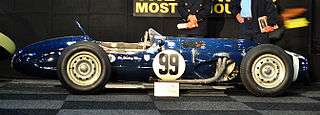Ferguson Research
Harry Ferguson Research Limited was a British company founded by Harry Ferguson who was mostly known as "the father of the modern farm tractor". He was also a pioneer aviator, becoming one of the first to build and fly his own aeroplane in Ireland, and also went on to develop four-wheel drive systems for cars including pioneering their use in Formula One racing cars. The company was based in Siskin Drive, in Coventry, England.
History

Harry Ferguson was part owner of the famous Massey Ferguson tractor company, but grew intrigued with the research of Tony Rolt and Freddie Dixon.[1] In 1950, they founded Ferguson Research Ltd.[2] Their offers of Ferguson 4WD to carmakers were ignored.[2] Over the next few years, Ferguson sold off his interest in Massey-Ferguson and turned to the construction of a Coventry-Climax powered 4WD Formula One car in 1960.
Despite the death of Ferguson later that year, the Ferguson P99 was raced during the 1961 season in UK F1 races by Rob Walker's team. The car raced only once in the World Championship at the British Grand Prix. However the car won a non-championship race, the 1961 International Gold Cup at Oulton Park with Stirling Moss as the driver. As of today, this is the only victory of a four-wheel drive car in F1 (and incidentally the last race won by Moss in Europe), with the technology banned in 1983.[3] Despite its promising beginnings this front-engined car was soon made obsolete by mid-engined cars.
Ferguson Research went on in racing, supplying the Novi-powered P104 to the STP team for Indianapolis. In 1964 the Ferguson P99, by then fitted with a 2.5 litre Climax engine, was lent to Peter Westbury who used it to win the British Hillclimb Championship that year. Ferguson later supplied 4WD transmissions to various Indy and F1 teams, with the BRM team using the Ferguson 4WD system on the BRM P67 car in 1964.
Ferguson Formula 4WD

Five years after Ferguson's death,[2] Jensen Motors took up the idea of a 4WD road car, stretching the Interceptor by 5 in (130 mm) to create the FF (for Ferguson Formula, Ferguson's term for 4WD).[2] It appeared in 1966. Design issues and cost kept it from being a commercial success. By 1969 the company was also contracted to make prototype conversions of several road cars for major manufacturers. These included a Dodge Challenger for Chrysler and Ford Zephyr police vehicles.
In 1969, there was a 4WD boom in F1 with the top teams of the era, Matra, Lotus and McLaren, building 4WD cars using the Ferguson system (Cosworth also built a 4WD car but using their own system). The 1968 seasons had seen many wet races and the constructors were searching for means to increase the grip of the cars. The 1969 British Grand Prix, saw a record number of four 4WD cars using the Ferguson system entered,[4] with John Miles in a Lotus 63 achieving the best finish of 10th.[4] 1969 also saw the introduction of wings in F1 and as there was no wet race that year, all the competitors ceased developing 4WD F1 cars as wings appeared as an easier way to increase grip. Team Lotus made a last attempt with the Ferguson system on the gas turbine powered Lotus 56B in 1971, but the car was uncompetitive. A new company called FF Developments was founded in 1971 by Rolt and continued to develop Ferguson's four-wheel drive systems.[5]
Complete Formula One World Championship results
(key)
| Year | Entrant | Chassis | Engine | Driver | 1 | 2 | 3 | 4 | 5 | 6 | 7 | 8 | Pts. | WCC |
|---|---|---|---|---|---|---|---|---|---|---|---|---|---|---|
| 1961 | Rob Walker Racing | Ferguson P99 | Climax L4 | MON | NED | BEL | FRA | GBR | GER | ITA | USA | 0 | – | |
| Jack Fairman/ Stirling Moss |
DSQ |
See also
References
Citations
- ↑ Lyons, Pete. "10 Best Ahead-of-Their-Time Machines", in Car and Driver, 1/88, p.78.
- 1 2 3 4 Lyons, p.78.
- ↑ Collantine, Keith (1 March 2007). "Banned! Six-wheelers". F1 Fanatic. Retrieved 13 January 2012.
- 1 2 "1969 British GP Race Report". Grandprix.com. Inside F1. Retrieved 13 January 2012.
- ↑ "Decembers Past 2001: 30 Years ago December 1971". Classic Driver. Retrieved 13 January 2012.
Bibliography
- Lyons, Pete. "10 Best Ahead-of-Their-Time Machines", in Car and Driver, 1/88
- Ferguson P99: The only four-wheel-drive F1 winner
- Results from Formula1.com